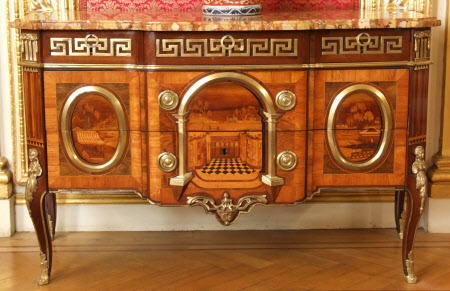Commode
Category
Furniture
Date
circa 1770
Materials
Oak and pine carcass, veneered with purpleheart, tulipwood, satiné, walnut, sycamore, fruitwood and ebony marquetry, gilt bronze mounts, Breccia di Aleppo marble top
Measurements
86 x 132 x 61 cm
Place of origin
Northern Europe
Order this imageCollection
Polesden Lacey, Surrey
NT 1245946
Summary
A marquetry breakfront commode, probably Northern European, in the French Transitional style, circa 1770, the shaped marble top above a frieze mounted with Greek-key opening with three drawers, above a pair of long drawers veneered in three section with marquetry, the central design with the perspective of a courtyard with chequered floor, the canted angles above on cabriole legs headed by female busts' mounts and terminated in acanthus cast sabots, the back side rails and legs are projected which is an unusual detail. The overall shape of this commode, the marquetry and the gilt-bronze mounts are characteristic of the Parisian workshops' production circa 1760. This type became very popular outside France and a few examples from Sweden, German and English makers are known. A commode at the Victoria and Albert Museum (3-1882) is dated 1779 and signed by George Haupt who became cabinetmaker to the King of Sweden in 1769 after training in Amsterdam, Paris and London. Another commode at Ham (NT 1140073) was first thought to be Swedish before it was attributed to an English cabinet-maker.
Provenance
Date of acquisition not recorded, but probably originally at 16 Charles Street, Mayfair, Mrs Greville's London home, and bequeathed by Margaret McEwan, The Hon. Mrs Ronald Greville (1863-1942) with Polesden Lacey, to the National Trust, in memory of her father, William McEwan (1827-1913) in 1942. This item found on the probate inventory record for Charles Street chattels at Polesden Lacey, found in the Dining Room, page 10.

